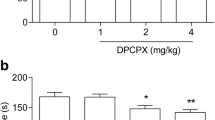Abstract
CGS 15943A is the first reported nonxanthine adenosine antagonist and it shows high affinity towards A1 and A2 receptors. The present data show that CGS 15943A increased in a dose-dependent manner locomotor activity of mice confronted with a free exploratory test without markedly modifying rears or, at low or medium doses, novelty seeking responses. In the light/dark choice procedure, which is especially appropriate for revealing anxiolytic and anxiogenic drug-effects, CGS 15943A decreased the time spent by mice in the lit box and increased the number of transitions. By contrast, the highly selective adenosine A1 receptor, DPCPX, did not significantly modify the behavior of mice except at high doses, which decreased it in the free exploratory test. It is suggested that the present findings confirm the hypothesis that the behavioral effects of adenosine antagonists are linked to their actions at adenosine A2 receptors.
Similar content being viewed by others
References
Baldwin HA, File SE (1989) Caffeine-induced anxiogenesis: role of adenosine, benzodiazepine and noradrenergic receptors. Pharmacol Biochem Behav 32:181–186
Barroco RA, Coffin VL, Altman HJ, Phillis JW (1983) Central effects of adenosine analogs on locomotor activity in mice and antagonism by caffeine. Brain Res 272:392–395
Bruns RF, Davis RE, Ninteman FW, Poschel BPH, Wiley JN, Heffner TG (1988) Adenosine antagonists as pharmacological tools. In: Pator DM (ed) Adenosine and adenine nucleotides. Physiology and pharmacology. Taylor & Francis, London, pp 39–49
Charney DS, Henninger GR, Jatlow PI (1985) Increased anxiogenic effects of caffeine in panic disorders. Arch Gen Psychiatry 42:233–243
Dunwiddie TV (1985) The physiological role of adenosine in the central nervous system. Int Rev Neurobiol 27:63–139
Durcan MJ, Morgan PF (1989) NECA-induced hypomotility in mice: evidence for predominantly central site of action. Pharmacol Biochem Behav 32:487–490
File SE, Baldwin HA, Johnston AI, Wilks LJ (1988) Behavioral effects of acute and chronic administration of caffeine in the rat. Pharmacol Biochem Behav 30:809–815
Fredholm BB, Hedqvist P (1980) Modulation of neurotransmission by purine nucleosides and nucleotides. Biochem Pharmacol 25:1583–1588
Ghai G, Francis JE, Williams M, Dotson RA, Hopkins MF, Cote DT, Goodman FR, Zimmerman MB (1987) Pharmacological characterization of CGS 15943A: a novel nonxanthine adenosine antagonist. J Pharmacol Exp Ther 242:784–790
Heffner TG, Wiley JN, Williams AE, Bruns RF, Coughenour LL, Downs DA (1989) Comparison of the behavioral effects of adenosine and dopamine antagonists in mice. Psychopharmacology 98:31–37
Henry J, Stephens P (1980) Caffeine is an intensifier of stress-indirect hormonal and pathophysiologic changes in mice. Pharmacol Biochem Behav 13:719–724
Logan L, Seale TW, Carney JM (1986) Inherent differences in sensitivity to methylxanthines among inbred mice. Pharmacol Biochem Behav 24:1281–1286
Lohse MJ, Klotz KN, Lindenborn-Fotinos J, Reddington M, Schwab U, Olsson RA (1987) 8-Cyclopentyl-1,3-dipropylxanthine (DPCPX) — a selective high affinity antagonist radioligand for A1 adenosine receptors. Naunyn-Schmiedberg's Arch Pharmacol 336:204–210
Loke WH, Hinrichs JV, Ghonheim MM (1985) Caffeine and diazepam: separate and combined effects on mood, memory and psychomotor performance. Psychopharmacology 87:344–350
Misslin R, Belzung C, Vogel E (1989) Behavioral validation of light/dark choice procedure for testing anti-anxiety agents. Behav Process 18:119–132
Nikodijevic O, Daly JW, Jacobson KA (1990) Characterization of the locomotor depression produced by an A2-selective adenosine agonist. FEBS 261:67–70
Robbins TW, Iversen SD (1973) A dissociation of the effects ofd-amphetamine on locomotor activity and exploration in rats. Psychopharmacologia 28:155–164
Sattin A, Rall TW (1970) The effect of adenosine and adenine nucleotides on the cyclic AMP content of guinea-pig cerebral cortex slices. Mol Pharmacol 6:13–23
Seale TW, Abla KA, Cao W, Parker KM, Rennert OM, Carney JM (1986) Inherent hyporesponsiveness to methylxanthine-induced behavioral changes associated with supersensitivity to 5'-N-ethylcarboxymidoadenosine (NECA). Pharmacol Biochem Behav 25:1271–1277
Shanahan MP, Hughes RM (1986) Potentiation of performance-induced anxiety by caffeine in coffee. Psychol Rep 59:83–86
Snyder SH, Katims JJ, Annau Z, Bruns RF, Daly JW (1981) Adenosine receptors and the behavioral actions of methylxanthines. Proc Natl Acad Sci USA 78:3260–3264
Spealman RD, Coffin VL (1986) Behavioral effects of adenosine analogs in squirrel monkeys: relation to adenosine A2 receptors. Psychopharmacology 90:419–421
Uhde TW, Boulenger JP, Jimerson DC, Post RM (1984) Caffeine and behaviour: relation to psychopathology underlying mechanisms. Psychopharmacol Bull 20:426–430
Williams M, Francis JE, Ghai G, Brauwalder A, Psychoyos S, Stone GA, Cash WD (1987) Biochemical characterization of the triazoloquinazoline, CGS 15943A, a novel, non-xanthine adenosine antagonist. J Pharmacol Exp Ther 241:415–420
Author information
Authors and Affiliations
Rights and permissions
About this article
Cite this article
Griebel, G., Saffroy-Spittler, M., Misslin, R. et al. Comparison of the behavioural effects of an adenosine A1/A2-receptor antagonist, CGS 15943A, and an A1-selective antagonist, DPCPX. Psychopharmacology 103, 541–544 (1991). https://doi.org/10.1007/BF02244256
Received:
Revised:
Issue Date:
DOI: https://doi.org/10.1007/BF02244256




